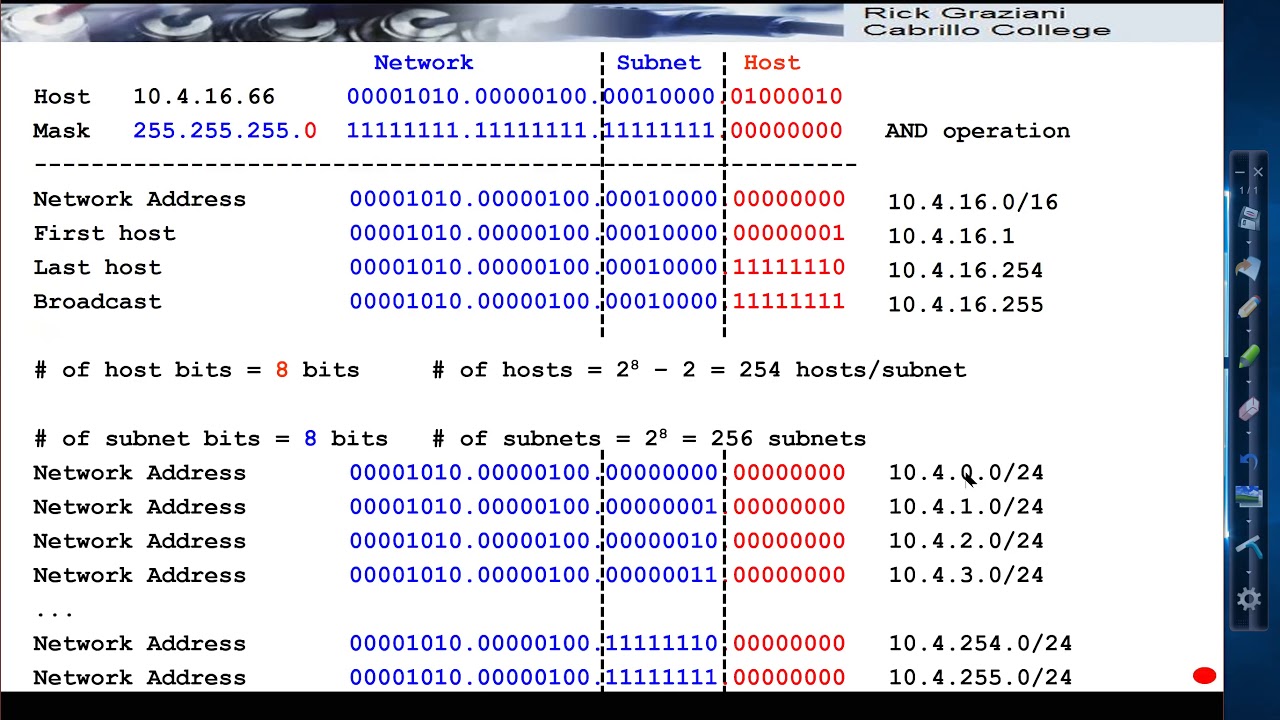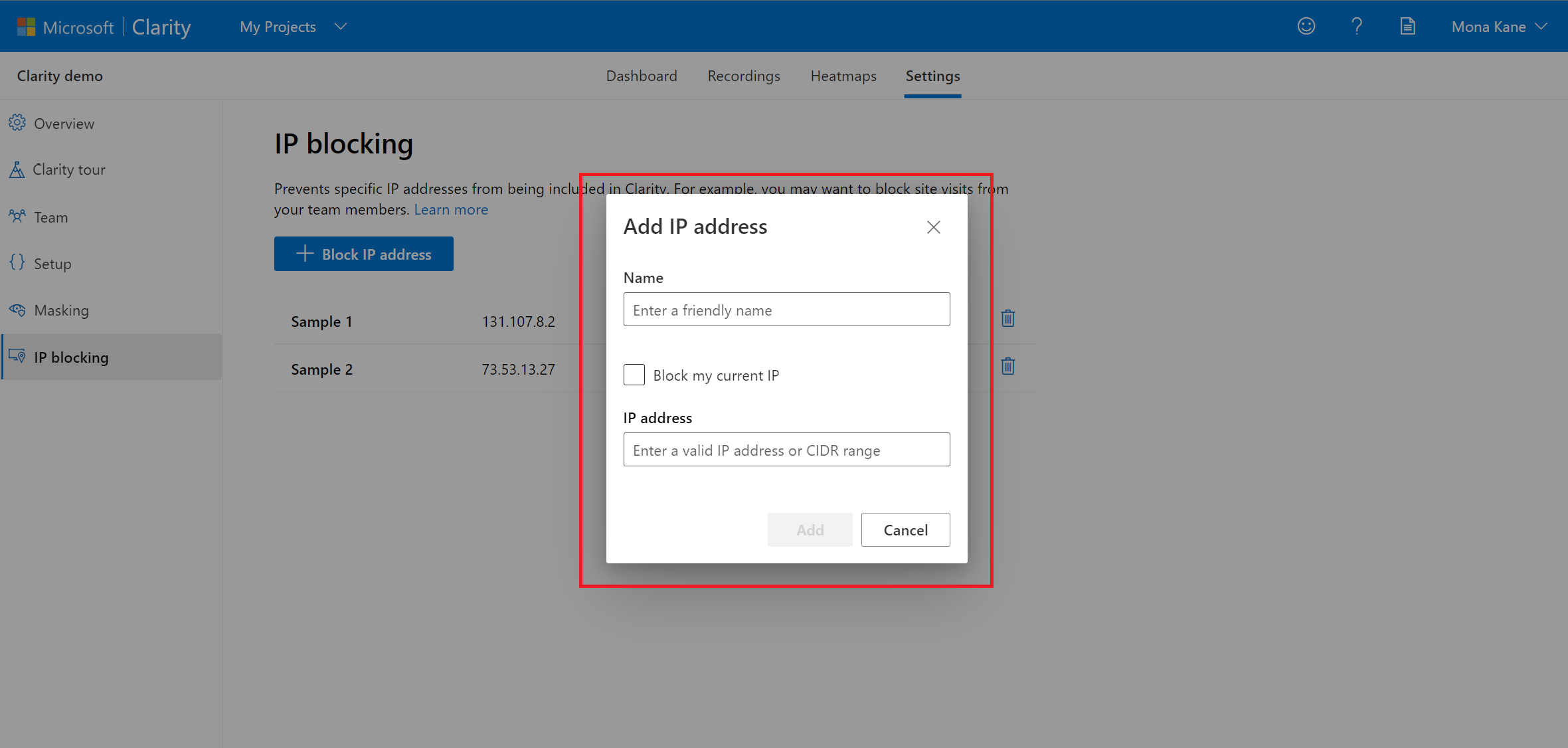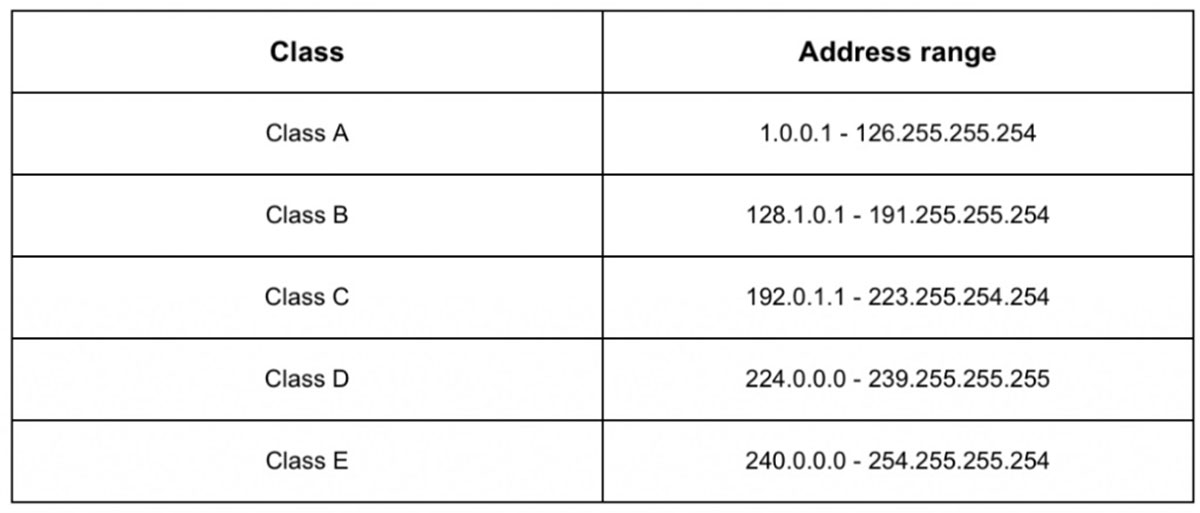What is CIDR?
CIDR, or Classless Inter-Domain Routing, is a technique used to efficiently allocate and manage IP addresses. It replaced the outdated classful IP addressing system and allowed for more flexible and granular allocation of address space. CIDR was introduced to overcome the limitations of the original IP addressing system, which was based on pre-defined classes (Class A, Class B, and Class C).
With CIDR, an IP address is represented by a combination of the network prefix and the host identifier. This allows for a more efficient utilization of address space and eliminates the need for large blocks of unused IP addresses, as was common in the classful system.
CIDR operates by using a notation called CIDR notation, which specifies the network prefix length. The network prefix length determines the number of bits used to represent the network portion of an IP address. For example, in CIDR notation, an IP address with a network prefix length of 24 is written as “x.x.x.0/24,” where the “x.x.x” represents the network address and the “/24” represents the number of bits used for the network portion.
This more flexible addressing system allows organizations to allocate IP addresses in smaller blocks, which can be more efficiently managed. Instead of being limited to fixed-sized blocks based on classful boundaries, CIDR allows for more granular allocation of IP addresses. This enables better optimization of address space, reduces the likelihood of address exhaustion, and simplifies network planning and management.
CIDR has become the standard for IP address allocation and routing in modern networks. It is widely used by internet service providers and organizations to manage their IP address space effectively. By adopting CIDR, they can allocate IP addresses more efficiently, reduce administrative overhead, and improve the scalability and performance of their networks.
How does CIDR work?
CIDR works by using the concept of subnetting to divide IP address space into smaller, more manageable blocks. The basic idea behind CIDR is to allocate IP addresses based on the actual need of the network, rather than following the rigid classful boundaries of the older IP addressing system.
To understand how CIDR works, let’s first look at the traditional classful addressing. In the classful system, IP addresses were divided into fixed-sized blocks called classes: Class A, Class B, and Class C. Each class had a fixed number of network bits and host bits, which determined the maximum number of networks and hosts that could be created. This rigid structure often resulted in inefficient allocation and wastage of IP addresses.
CIDR, on the other hand, allows for variable-length subnet masks (VLSM), which means that the network prefix can be of any length. This flexibility enables better utilization of IP addresses by allocating smaller blocks as needed.
CIDR works by assigning a network prefix length, expressed as a number of bits, to an IP address. The higher the number of bits in the network prefix, the smaller the subnet becomes. For example, a network prefix length of /24 reserves 24 bits for the network portion of the IP address, allowing for 256 possible network addresses.
Using CIDR notation, network administrators can allocate IP addresses in a more efficient and granular manner. This not only conserves IP address space but also enables finer control over routing and network management.
CIDR also enables route aggregation by consolidating multiple smaller network blocks into a single larger block. This reduces the number of routing table entries, making routing more efficient and scalable.
In addition to subnetting, CIDR also introduced the concept of supernets, which allow contiguous network blocks to be combined under a single network prefix. This simplifies routing and reduces the size of routing tables.
Overall, CIDR revolutionized IP addressing by providing a flexible and efficient means of allocating and managing IP address space. It allows for better utilization of IP addresses, simplifies network planning and management, and improves routing performance.
Benefits of using CIDR
CIDR, or Classless Inter-Domain Routing, offers several benefits over the traditional classful IP addressing system. By adopting CIDR, organizations and internet service providers can effectively manage IP address space, optimize routing, and improve network scalability. Here are some key advantages of using CIDR:
1. Efficient IP address allocation: CIDR allows for more granular allocation of IP addresses, eliminating the wastage that often occurred with the fixed block sizes of the classful system. This ensures that IP address space is utilized efficiently, reducing the likelihood of address exhaustion.
2. Flexibility in address allocation: With CIDR, organizations can allocate IP addresses in blocks of any size, depending on their specific needs. This flexibility enables better optimization of IP address space, as smaller blocks can be allocated where required, while larger blocks can be used for future expansion.
3. Simplified network management: The flexibility of CIDR makes network planning and management easier. Network administrators can allocate IP addresses in a way that aligns with their organizational structure and network requirements. This reduces administrative overhead and enables more efficient resource allocation.
4. Improved routing scalability: CIDR allows for route aggregation, which reduces the size of routing tables and improves routing scalability. By consolidating smaller network blocks into larger blocks, CIDR minimizes the number of routing table entries, making routing more efficient and reducing the burden on routers.
5. Enhanced network performance: CIDR improves network performance by optimizing routing. With the ability to aggregate routes and reduce routing table size, CIDR reduces the processing overhead on routers and improves the efficiency of data transmission.
6. Seamless transition to IPv6: CIDR played a crucial role in the transition from IPv4 to IPv6. By introducing the concept of variable-length subnet masks, CIDR paved the way for the efficient allocation of IPv6 addresses. This ensured a smooth migration to a larger and more scalable IP address space.
In summary, CIDR offers numerous benefits, including efficient IP address allocation, flexibility in address allocation, simplified network management, improved routing scalability, enhanced network performance, and a seamless transition to IPv6. By adopting CIDR, organizations can optimize their IP address usage, improve network efficiency, and effectively meet the demands of modern networking environments.
Classless Inter-Domain Routing (CIDR) notation
CIDR notation is a compact and standardized representation of IP addresses and their network prefixes. It is used in the Classless Inter-Domain Routing (CIDR) system to denote the length of the network prefix in an IP address.
In CIDR notation, an IP address is followed by a slash (“/”) and a number, which represents the network prefix length. The network prefix length specifies the number of bits used to represent the network portion of the IP address.
For example, an IP address of 192.168.0.0 with a network prefix length of 24 is written as “192.168.0.0/24”. In this notation, the first 24 bits represent the network portion of the address, while the remaining bits are used for host identification.
The network prefix length can range from 0 to 32 for IPv4 addresses, and from 0 to 128 for IPv6 addresses. A network prefix length of 0 indicates that the IP address represents the entire network, while a length of 32 (or 128 for IPv6) indicates a specific host address.
CIDR notation allows for a more efficient representation of IP addresses, as it eliminates the need to express the entire network portion in decimal format. Instead, the network prefix length provides a concise and standardized way to denote the network boundaries.
Using CIDR notation, network administrators can easily allocate and plan IP address space. They can define the size of subnets and the number of hosts in each subnet based on the desired network architecture.
CIDR notation also plays a crucial role in routing. It allows routers to efficiently determine the destination network by comparing the network prefix of the IP address with the routing table entries. By matching the longest network prefix, routers can forward packets to the correct destination with minimum overhead.
Overall, CIDR notation simplifies IP address representation, enhances network planning and routing efficiency, and provides a common language for network administrators and routers to communicate network boundaries.
CIDR blocks and subnetting
CIDR blocks and subnetting go hand in hand when it comes to effectively managing IP addresses and designing networks. CIDR blocks represent a range of IP addresses, while subnetting divides a CIDR block into smaller subnets.
CIDR blocks are defined by the network prefix length. For example, a CIDR block of /24 represents a block of 256 IP addresses. The number after the slash (“/”) indicates the number of network bits that are fixed for all IP addresses within the block. The remaining bits are used for host identification.
Subnetting takes a CIDR block and further divides it into smaller subnets. Each subnet is allocated a portion of the available IP addresses within the CIDR block. The size of each subnet is determined by the network prefix length assigned to it.
Subnetting allows for better organization and management of IP addresses. It enables network administrators to allocate IP addresses as needed, based on the requirements of different network segments or departments within an organization. For example, a large CIDR block might be divided into smaller subnets for different floors of a building, different departments, or different types of devices.
The subnet mask determines the number of bits used for the network portion of the IP address. For example, a subnet mask of 255.255.255.0 (equivalent to /24) means that the first 24 bits represent the network portion, while the remaining 8 bits can be used for host identification within the subnet.
Subnetting also enables efficient use of IP addresses by allowing for the allocation of smaller address blocks where needed. Rather than assigning large CIDR blocks to every subnet, subnetting allows for the creation of subnets with only the necessary number of IP addresses, reducing wastage.
By using subnetting and CIDR blocks, network administrators have greater flexibility in network design and IP address allocation. They can create subnets of varying sizes, accommodating different network requirements. Subnets can be easily expanded or reconfigured as needed without impacting other parts of the network.
In summary, CIDR blocks and subnetting are essential concepts for effective IP address management and network design. CIDR blocks represent a range of IP addresses, while subnetting divides those blocks into smaller subnets. This allows for better organization, flexibility, and efficiency in IP address allocation and network planning.
Understanding CIDR address range
CIDR, or Classless Inter-Domain Routing, introduced a more flexible way to represent IP addresses and their ranges. In CIDR, the concept of address range refers to a contiguous set of IP addresses within a CIDR block that share the same network prefix.
Each CIDR block has a network prefix length, which indicates the number of bits used to represent the network portion of an IP address. The remaining bits are available for host identification within the address range.
Understanding the CIDR address range is crucial for network administrators and designers as it allows them to determine the available IP addresses and define subnets within the CIDR block.
To calculate the address range within a CIDR block, you need to know the network prefix length and the base IP address of the block. The base IP address represents the starting point of the address range.
For example, consider a CIDR block with a network prefix length of /24 and a base IP address of 192.168.0.0. This CIDR block would represent an address range from 192.168.0.0 to 192.168.0.255. The first address, 192.168.0.0, is reserved as the network address, and the last address, 192.168.0.255, is reserved as the broadcast address.
The address range within the CIDR block can be further divided into subnets. Subnetting allows for the allocation of smaller ranges within the CIDR block to different network segments or devices.
For example, using the same CIDR block of /24, you could create subnets with different network prefix lengths. By assigning a network prefix length of /26, you would create subnets with 62 available IP addresses. The first usable IP address in each subnet would be the network address plus one, and the last usable IP address would be the broadcast address minus one.
Understanding the CIDR address range is essential for efficient IP address allocation. It allows network administrators to assign IP addresses within the available range and avoid conflicts. It also helps in organizing networks and subnets based on specific requirements.
By understanding the CIDR address range, network designers can plan their networks more effectively, ensuring that IP addresses are allocated correctly and that there is sufficient room for growth and future expansion.
In summary, the CIDR address range refers to the set of IP addresses within a CIDR block that share the same network prefix. It is determined by the network prefix length and the base IP address of the CIDR block. Understanding the CIDR address range is crucial for proper IP address allocation and network planning.
How to calculate the CIDR notation
Calculating the CIDR notation involves determining the network prefix length based on the number of addresses required for a subnet or network. The process of calculating CIDR notation can be broken down into a few steps:
1. Determine the number of required host addresses: Start by determining the number of host addresses needed for your network or subnet. Include both usable addresses for devices and any additional addresses required for network or subnet identification, such as the network address and the broadcast address.
2. Find the binary representation of the number of required host addresses: Convert the number of required host addresses into binary form. This will help determine the number of host bits required for the network prefix.
3. Calculate the number of host bits: Count the number of bits required to represent the number of host addresses. This will indicate how many bits you need to allocate for the host portion of the IP address.
4. Determine the network prefix length: Subtract the number of host bits from the total number of bits in an IP address (32 for IPv4 or 128 for IPv6). The result will be the network prefix length. For example, a network prefix length of 24 indicates that the first 24 bits represent the network portion of the address.
5. Represent the IP address in CIDR notation: Write the IP address followed by a slash (“/”) and the network prefix length. For example, if the IP address is 192.168.0.0 and the network prefix length is 24, the CIDR notation would be “192.168.0.0/24”.
It’s important to note that CIDR notation is typically used for subnetting and routing purposes. By specifying the network prefix length, it allows routers to determine how to route packets to the correct destination network.
Calculating the CIDR notation is an essential skill for network administrators and designers. It ensures proper allocation of IP addresses, optimal utilization of address space, and efficient routing within the network.
In summary, calculating the CIDR notation involves determining the network prefix length based on the required number of host addresses. By following the steps outlined above, you can calculate the CIDR notation and allocate IP addresses effectively for your network or subnet.
CIDR and IP address allocation
CIDR, or Classless Inter-Domain Routing, revolutionized IP address allocation by introducing a more flexible and efficient system. It allows for variable-length subnet masks (VLSM), which means IP addresses can be allocated in smaller blocks based on the actual needs of the network.
CIDR simplifies IP address allocation by providing a scalable and granular approach. Instead of being constrained by fixed block sizes, as was the case with the classful IP addressing system, CIDR allows network administrators to allocate IP addresses in variable-size blocks called subnets. This ensures that IP address space is utilized efficiently and reduces the likelihood of address exhaustion.
IP address allocation with CIDR involves the following steps:
1. Determine the network requirements: Before allocating IP addresses, it is important to assess the network requirements. This includes considering the number of devices, the number of subnets, and any future growth projections.
2. Define subnet sizes: Based on the network requirements, determine the size of subnets needed. This can be done by calculating the number of required host addresses for each subnet.
3. Allocate IP addresses to subnets: Once the subnet sizes are defined, allocate IP addresses to the respective subnets. This involves assigning a network prefix length to each subnet based on the number of required host addresses. The network prefix length determines the size of the subnet and is represented in CIDR notation.
4. Manage IP address space: As IP addresses are allocated to subnets, track and manage the IP address space to prevent conflicts and ensure efficient allocation. This can be done through proper documentation and IP address management tools.
CIDR allows for the efficient utilization of IP address space by allocating addresses as per the network’s actual needs. This avoids the wastage that occurred with classful addressing, where large blocks of IP addresses were often left unused.
Furthermore, CIDR enables hierarchical addressing, where larger blocks are divided into smaller subnets. This hierarchical structure allows for better organization, easier management, and simpler scalability.
IP address allocation with CIDR also facilitates efficient routing. By using CIDR notation, routers can match the longest network prefix in their routing tables to determine the correct path for packet forwarding. This reduces the size of routing tables and enhances routing efficiency.
In summary, CIDR transformed IP address allocation by introducing a more flexible and efficient system. It allows for variable-length subnet masks, enabling IP addresses to be allocated in smaller blocks based on network needs. This approach improves IP address utilization, simplifies management, and enhances routing efficiency within the network.
CIDR and routing protocols
CIDR, or Classless Inter-Domain Routing, has had a significant impact on routing protocols by enabling more efficient routing and better utilization of IP address space. Routing protocols are responsible for determining the best path for data packets to travel through a network. CIDR has introduced features that improve the scalability and performance of routing protocols.
CIDR’s impact on routing protocols can be seen in several key areas:
1. Route aggregation: CIDR allows for route aggregation, which reduces the size of routing tables. Route aggregation involves consolidating multiple smaller network blocks into a single larger block. This aggregation minimizes the number of routing table entries, making routing more efficient and reducing the processing overhead on routers.
2. Classless routing: The classful IP addressing system had rigid boundaries based on fixed block sizes. CIDR introduced classless routing, where the network prefix length is included in the routing table entry. This enables routers to make more precise routing decisions based on the length of the network prefix, rather than relying solely on classful boundaries.
3. Variable-length subnet masks (VLSM): VLSM is a key feature of CIDR that allows network administrators to allocate IP addresses in variable-length subnet masks. This means that different subnets within a network can have different subnet mask lengths, providing more granularity in IP address allocation. Routing protocols that support CIDR and VLSM can take advantage of this flexibility by optimizing routing decisions based on the network prefix length.
4. Supernetting: CIDR introduced the concept of supernets, which are contiguous network blocks combined under a single network prefix. Supernets simplify routing by reducing the number of routing table entries and making the routing process more efficient. Routing protocols that support supernets can handle large address spaces more effectively and reduce the complexity of routing tables.
CIDR’s influence on routing protocols has been profound. It has improved routing efficiency, reduced the size of routing tables, and enabled the efficient allocation of IP addresses. As networks continue to grow and evolve, CIDR plays a critical role in optimizing routing protocols and supporting scalable and efficient routing mechanisms.
Routing protocols, such as Border Gateway Protocol (BGP), Open Shortest Path First (OSPF), and Routing Information Protocol (RIP), have been enhanced to support CIDR and take advantage of its benefits. By embracing CIDR, networks can achieve improved performance, scalability, and flexibility in their routing infrastructure.
In summary, CIDR has transformed routing protocols by introducing features like route aggregation, classless routing, VLSM, and supernetting. These features enhance routing efficiency, reduce routing table size, and enable more flexible IP address allocation. By supporting CIDR, routing protocols can adapt to the needs of modern networks and achieve higher levels of performance and scalability.
CIDR and IPv6
CIDR, or Classless Inter-Domain Routing, has played a crucial role in the adoption and implementation of IPv6, the next-generation Internet Protocol. IPv6 was developed to address the limitations of IPv4, such as address exhaustion and the need for improved scalability. CIDR has provided a framework for better utilization of IP address space in IPv6 and has facilitated the transition from IPv4 to IPv6.
CIDR in IPv6 operates similarly to CIDR in IPv4, but with a larger address space. IPv6 uses a 128-bit address format, allowing for a vast number of unique IP addresses. CIDR notation remains the standard for representing IPv6 addresses and their network prefixes.
CIDR in IPv6 enables efficient allocation of IP addresses and improves routing scalability. With CIDR, network administrators can allocate IPv6 addresses in variable-sized blocks, based on their specific needs. This flexibility ensures optimal utilization of the massive IPv6 address space and reduces the likelihood of address exhaustion.
Routing in IPv6 also benefits from CIDR. CIDR notation specifies the network prefix length, which enhances routing efficiency by allowing routers to make more precise routing decisions based on the length of the network prefix. Route aggregation, a feature of CIDR, reduces the size of routing tables and simplifies the routing process in IPv6 networks.
CIDR has also paved the way for the deployment of Classless Inter-Domain Routing security extensions (CIDR-SE). CIDR-SE provides additional security features, such as encrypted communication between networks using public and private key pairs. These extensions ensure the secure transmission of routing information through the use of digital signatures and provide enhanced security for CIDR-based routing protocols in IPv6 networks.
The adoption of CIDR in IPv6 has been instrumental in the successful implementation of the new protocol. CIDR has enabled efficient address allocation, improved routing scalability, and enhanced security features. With the support of CIDR, IPv6 has become the foundation for a future-proof and scalable Internet.
As the world continues to transition from IPv4 to IPv6, CIDR will remain a critical component in the efficient allocation and management of IPv6 IP addresses. It will continue to facilitate the routing of data packets in IPv6 networks and support the growth and expansion of the Internet on a global scale.
In summary, CIDR has played a vital role in the deployment of IPv6, providing a framework for efficient IP address allocation, improved routing scalability, and enhanced security. CIDR in IPv6 ensures the optimal utilization of the vast IPv6 address space and sets the stage for a more secure and scalable Internet infrastructure.

























